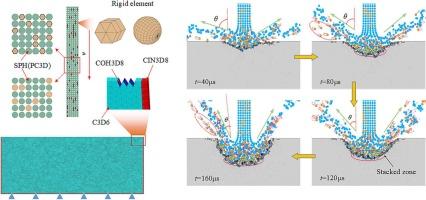基于 SPH-FDEM 方法的磨料水射流冲击岩石时的损伤和能耗模拟分析
IF 4.5
2区 工程技术
Q2 ENGINEERING, CHEMICAL
引用次数: 0
摘要
本研究基于 SPH-FDEM 方法建立了加砂水射流破岩模拟模型。基于该模型研究了磨料浓度和喷射速度对裂缝和能量消耗的影响。比较了有限元边界和无限元边界对模拟结果的影响,发现无限元边界可以减轻应力波反射对岩石造成的破坏。在水射流破岩过程中,由于水的楔形效应,岩石内部的裂缝模式以 Mode-I 裂缝(开口模式裂缝)为主,裂缝数量和破碎体积随着速度和磨料浓度的增加而增加。本研究采用比能量消耗(SEC)来评估破岩能力。在纯水喷射条件下,SEC 随速度的增加而降低,而在添加磨料后,SEC 随速度和磨料浓度的增加而升高。这些发现为优化工程应用中的水射流加工参数提供了依据。本文章由计算机程序翻译,如有差异,请以英文原文为准。

Simulation analysis of damage and energy consumption of rocks during abrasive water jet impacts based on SPH-FDEM method
This study established a simulation model for abrasive water jet rock breaking based on the SPH-FDEM method. The effects of abrasive concentration and jet velocity on crack and energy consumption were investigated based on the model. The effect of finite and infinite element boundaries on simulation results was compared, and it was found that the infinite element boundary can mitigate the damage caused by stress wave reflection on rocks. During water jet rock breaking, the crack mode inside the rock was dominated by Mode-I crack (opening-mode crack) due to the water wedge effect, and the number of cracks and the broken volume increased with increasing velocity and abrasive concentration. In this study, the specific energy consumption (SEC) was used to evaluated the rock-breaking capacity. Under pure water jetting, the SEC decreased with increasing velocity, while with the addition of abrasive, the SEC increased with increasing velocity and abrasive concentration. These findings provided a basis for optimization of water jet machining parameters in engineering applications.
求助全文
通过发布文献求助,成功后即可免费获取论文全文。
去求助
来源期刊

Powder Technology
工程技术-工程:化工
CiteScore
9.90
自引率
15.40%
发文量
1047
审稿时长
46 days
期刊介绍:
Powder Technology is an International Journal on the Science and Technology of Wet and Dry Particulate Systems. Powder Technology publishes papers on all aspects of the formation of particles and their characterisation and on the study of systems containing particulate solids. No limitation is imposed on the size of the particles, which may range from nanometre scale, as in pigments or aerosols, to that of mined or quarried materials. The following list of topics is not intended to be comprehensive, but rather to indicate typical subjects which fall within the scope of the journal's interests:
Formation and synthesis of particles by precipitation and other methods.
Modification of particles by agglomeration, coating, comminution and attrition.
Characterisation of the size, shape, surface area, pore structure and strength of particles and agglomerates (including the origins and effects of inter particle forces).
Packing, failure, flow and permeability of assemblies of particles.
Particle-particle interactions and suspension rheology.
Handling and processing operations such as slurry flow, fluidization, pneumatic conveying.
Interactions between particles and their environment, including delivery of particulate products to the body.
Applications of particle technology in production of pharmaceuticals, chemicals, foods, pigments, structural, and functional materials and in environmental and energy related matters.
For materials-oriented contributions we are looking for articles revealing the effect of particle/powder characteristics (size, morphology and composition, in that order) on material performance or functionality and, ideally, comparison to any industrial standard.
 求助内容:
求助内容: 应助结果提醒方式:
应助结果提醒方式:


